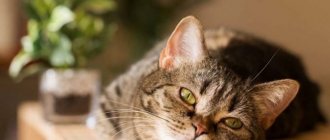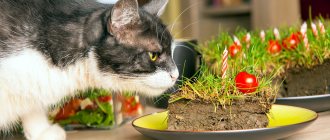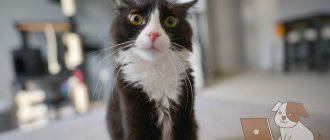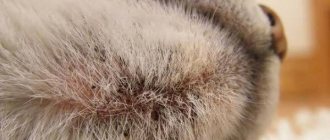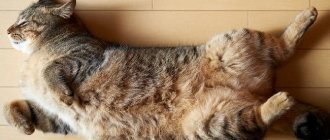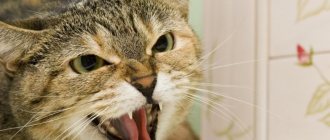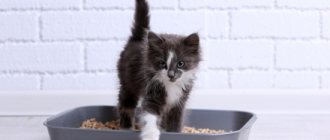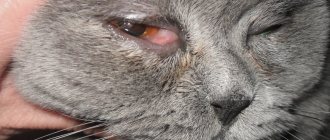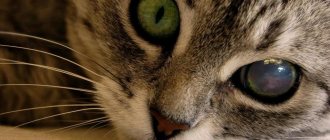Representatives of the cat family are animals of extraordinary beauty, attracting the eye with their grace and plasticity. However, owners often begin to notice that their pet is losing most of its grace, its tummy looks like a ball, and because of the pungent odor that the pet emits, it is impossible to be in the same room with it.
What to do?
Bloating is an abnormal enlargement of the abdominal cavity. The term usually refers to abdominal enlargement rather than simple fullness. In a cat, bloating can be a consequence of poor nutrition or a symptom of a large number of diseases, including fatal ones. The most common causes of this phenomenon are discussed below.
Coprostasis
Constipation, or coprostasis, is a blockage of the large intestine with feces. The causes of coprostasis may be the following:
- A sharp transition from mother's milk to other foods.
- Binge eating.
- Eating bones, especially heat-treated ones.
- Low protein content in the diet.
- Accumulation of hair in the gastrointestinal tract (when licking itself, the cat swallows some hair).
- Dehydration from not drinking enough.
and:
- A large number of worms.
- Prostate enlargement (in males).
- Abscess or cyst in the intestinal tract.
- Obesity.
- Problems with intestinal motility.
The norm is considered to be stool once a day. When feeding natural food, periodic absence of stool for 3 days is acceptable.
Symptoms:
- Oblong lumps can be felt in the abdomen.
- Vomiting (often with constipation from wool).
Treatment:
- Warm water enema.
- Vaseline oil - 1 ml per kg of body weight at intervals of 8-10 hours orally (it is important to avoid getting into the lungs).
- Magnesium sulfate – 20 ml of concentrated water solution, orally.
Helminthiasis
It is almost impossible to protect a cat from worms. A pet can pick them up through contact with outdoor shoes, from an eaten insect, from raw or undercooked fish or meat. They affect internal organs. Symptoms:
- Bloating.
- Constipation alternating with diarrhea.
- Worms in feces indicate a large number of them in the body.
- Nausea.
- Vomiting with worms.
Treatment consists of using anthelmintic drugs for external and internal use.
Panleukopenia
Feline distemper, or panleukopenia, is caused by one of the parvoviruses. Summer and late autumn are the most favorable times for the spread of the virus. Its carriers can be blood-sucking insects, ticks and healthy animals.
2–12 days after the virus enters the gastrointestinal tract, it affects the intestinal mucosa, lymphoid tissue and bone marrow.
In animals older than 3 months, the disease causes the following symptoms:
- Body temperature 40–41 degrees.
- Weight loss.
- Refusal to drink despite being thirsty.
- Vomit.
- Diarrhea.
- Bloating.
- Severe abdominal pain.
About a week after the onset of symptoms, the cat has a 50% chance of recovery generally. If the temperature drops to 37–38 degrees, the likelihood of death increases. If a kitten from 1 to 3 months is infected with parvovirus, the probability of death is close to 100%.
When diagnosing panleukopenia, other diseases with similar symptoms should be excluded:
- Poisoning.
- Non-contagious gastroenteritis.
- Lymphosarcoma.
- Toxoplasmosis.
When treating panleukopenia, depending on the nature of the course, the following are used:
- Drugs against the virus.
- Drugs that activate the immune system.
- Drugs that support the functions of the cardiovascular system.
- Antiemetic drugs.
- Broad spectrum antibiotics.
- Drugs that restore electrolyte balance.
- Painkillers and antispasmodics.
During the recovery period, the following diet is necessary:
- Fresh lactic acid products.
- Rice water with the addition of boiled egg white.
- Puree soups from cereals, vegetables with the gradual inclusion of boiled minced meat.
Immunity after illness lasts 3–4 years. Prevention consists of vaccination and hygiene.
Peritonitis
Inflammation of the peritoneum during a general severe condition of the body is called peritonitis. The cause is usually the penetration of infection into the abdominal cavity from the organs. This disease is often caused by a coronavirus. There are 2 forms of coronavirus peritonitis – wet and dry.
Peritonitis
The wet form leads to death 1–1.5 months after the onset of symptoms:
- The abdomen is enlarged and soft.
- Fever.
- Lethargy.
- Loss of appetite.
- Weight loss.
The dry form leads to death a year after the onset of the disease. The symptoms are the same as with the wet form, with the exception of an enlarged abdomen. There is no treatment for coronavirus peritonitis; sick animals must be euthanized.
Coronavirus usually enters a cat's digestive tract from the feces of an infected animal. Not all carriers of the virus get sick. Stress can provoke disease in healthy carriers. Most often, kittens from 1 to 4 months get sick. Predisposition to the disease is inherited.
Prevention:
- Avoiding stress.
- Avoiding crowding of animals.
- Maintaining hygiene rules.
Abdominal dropsy, or ascites, is an accumulation of fluid in the abdominal cavity without an inflammatory process. The reason for this may be:
- Heart failure.
- Liver failure.
- Disturbances of water-salt and protein metabolism.
- Abdominal wall lesions.
Symptoms:
- Bloated belly
- Reducing bowel sounds.
- Difficulty breathing.
- Difficulty in cardiac activity.
- Inactivity.
- Yellowness of mucous membranes.
Treatment:
- Diuretics.
- Cardiotonic drugs.
- Pumping out liquid.
- Limiting water and salt.
- Protein diet.
In case of acute urinary retention, the bladder may rupture, its contents may enter the abdominal cavity and peritonitis may occur. Urinary retention is not always easy to notice, as many litters instantly absorb urine. If your pet assumes a characteristic posture for urination very often, it means it is not happening. In this case, one of the following treatment options is urgently required:
- Bladder catheterization - insertion of a tube for the free flow of urine.
- Cretrostomy - making an incision for the free flow of urine.
Both treatments are performed under general anesthesia.
In the article I will list the main reasons why a cat has a swollen belly (constipation, gas, disease, etc.). I'll tell you how to help your pet and when you should contact a veterinarian.
Bloat can happen for many reasons, and some of them can be life-threatening for your pet.
A kitten's belly may become bloated due to certain foods. Often, flatulence (accumulation of gases in the intestines) results from feeding your pet milk and dairy products (especially for adult animals).
The cause of bloating may be the high content of carbohydrates in the menu: wheat, corn, etc.
Constipation is an accumulation of stool that becomes dry and hard and cannot be passed out on its own. This leads to intoxication of the body, and gases begin to accumulate in the intestines, which cause bloating.
Constipation occurs for many reasons:
- incorrectly composed diet;
- intestinal obstruction;
- accumulation of wool in the stomach;
- congenital anomalies;
- obesity and inactivity.
We suggest you read: Symptoms of worms in cats, how to recognize them by signs, treatment. Constipation can cause bloating in a cat.
Parasites actively multiply in the pet’s intestines and cause intoxication. Along with bloating, the cat also experiences other symptoms: vomiting, bowel irregularities, and the presence of worms in the feces. Moreover, the cat may be thin, but with a bloated intestine.
The animal eats a lot
Cats that eat very greedily and eat a lot often suffer from flatulence. At the same time, they swallow food without chewing it, which leads to large amounts of air entering the intestines and stomach. As a result, the intestines can swell to incredible sizes. Usually the animals themselves who live in shelters or nurseries eat so greedily.
Overeating leads to bloating in animals
Enlarged intestines can be a symptom of serious diseases of the internal organs:
- Pyometra. With this disease, pus accumulates in the cat's uterus, which is accompanied by an enlargement of the abdominal cavity. Associated symptoms: depression, fever (not always present), discharge from the loop.
- Peritonitis. An enlarged abdomen or ascites (accumulation of fluid in the abdominal cavity) accompanies the wet form of coronavirus infection (FIP).
- Tumors. The volume of the abdomen may increase significantly due to a malignant tumor in the abdominal cavity.
Bloating can occur with intestinal obstruction. This condition is life-threatening and requires immediate surgery. Some diseases can cause bloating
Now let's talk about what to do to eliminate a bloated belly in your pet. The method of eliminating bloating depends on the root cause of this condition:
- If flatulence was caused by poor nutrition, it is necessary to exclude all gas-forming products (primarily milk) from the pet’s diet. You can also give your pet Espumisan, Lactobacterin or Acipol.
- In case of constipation, it is necessary to exclude obstruction. If it is not there, the pet is first given Vaseline oil, and if it does not give an effect, then you can use laxatives (Lactusan, Duphalac, etc.).
- If the bloating was caused by helminths, you should give your pet a drug against these parasites. The following drugs are most effective: Milbemax, Kanikvantel, Prazitel, Drontal. In case of severe infestation, the medicine is given twice, with a break of 10 days.
- If the bloating was caused by overeating or the cat greedily swallowing air while eating, you can first fill the dry food with warm water. It is also recommended to provide your pet with constant access to food (in this case, a strictly daily amount is poured into the bowl per day).
In the event that an enlarged abdomen is the result of diseases of the internal organs, it is necessary to show the pet to a veterinarian.
Treatment of a cat should depend on the diagnosis
If your pet exhibits symptoms such as vomiting, pain, and drooling along with a bloated belly, you should consult a veterinarian.
The doctor will prescribe the necessary tests and examinations (blood tests, ultrasound, x-rays, etc.), after which he will prescribe the appropriate treatment:
- A pathological condition such as pyometra requires immediate surgical intervention. During the operation, the doctor carefully removes the uterus along with the pus that has accumulated in it.
- If the abdomen has become enlarged due to infectious peritonitis, the doctor will prescribe supportive treatment: antibiotics and corticosteroids. Also, with the wet form of FIP, the fluid that accumulates in the abdomen is periodically pumped out.
- If a cat has an obstruction, the doctor will prescribe an immediate operation, during which the root cause of this condition (foreign body, tumor, etc.) will be eliminated.
How to distinguish acute thrombosis of the external hemorrhoid from other diseases?
Usually, to diagnose acute thrombosis, it is enough to examine the patient and find out how the disease developed and what complaints are of concern. Upon examination, you can see an enlarged (sometimes up to several centimeters) node, often dark red in color, located outside the anus, possibly with a focus of necrosis in the center. When palpating (feeling) in the first few days, you can clearly identify a blood clot in the node; when examined at a later date, the blood clot is no longer so easy to determine; it begins to gradually “dissolve” and is partially replaced by scar tissue. Thrombosis of the external hemorrhoid must be distinguished from
strangulation of a prolapsed internal hemorrhoid. In this situation, prolapse of the internal hemorrhoidal node, normally located inside the anal canal, compression of its pedicle, in which the vessels feeding it pass, and disruption of the blood supply (ischemia) with death of the tissue of the node (Fig. 4 and 5). It is not difficult for a specialist to distinguish between these conditions, but it is quite difficult for a patient to independently understand which node is causing him discomfort. It is important to distinguish between these diseases, as their treatment varies significantly. When an internal hemorrhoid is strangulated, urgent surgical treatment is usually required.
Rice. 4. A strangulated prolapsed internal hemorrhoid with signs of tissue necrosis of the node.
Fig.5. Schematic representation of a strangulated internal prolapsed hemorrhoid.
Acute (exacerbation of chronic) anal fissure - accompanied by the same pain syndrome as with thrombosis, but much more pronounced at the time of bowel movement. With this disease, a rupture of the anal canal mucosa occurs. The appearance of an acute fissure is often associated with a reflex “protective” spasm of the sphincter apparatus, which complicates wound healing. Conservative and surgical treatment of diseases are different.
Acute paraproctitis - similarity with acute thrombosis lies in the appearance of a space-occupying formation in the anus, severe pain. Paraproctitis is an infectious and inflammatory disease with the formation of an abscess (abscess) in the pararectal area. The disease is accompanied by an increase in body temperature and general symptoms of intoxication. A mass formation in the anal canal area is much larger and more painful than with thrombosis. There is often discharge of pus onto the skin or into the lumen of the rectum. Ultrasound examination is used for accurate diagnosis. The disease is extremely dangerous due to the development of chronic purulent fistulas of the perianal area in the absence of adequate and timely treatment.
When is self-medication possible?
It is possible to treat bloating in a cat without involving a veterinarian only if there is simple flatulence in which there is no manifestation of any other disease. In other cases, an immediate visit to a veterinary clinic is necessary. Answering the question of what to do if a cat’s stomach is swollen, we can advise the following :
- Hilak Forte - Give 1 drop per 1 kg of weight once a day, until complete recovery;
- Smecta;
- Enterosgel;
- Children's espumesan.
All 3 drugs are selected in a dosage that is calculated based on the weight of the pet.
A bloated belly in a cat is a dangerous condition and its cause must be identified. This is often a symptom of a serious injury. The problem should be resolved with the involvement of a veterinarian. If the cat begins to bloat before our eyes, and there is no urinary retention, it is necessary to give medication for allergies, since this is most likely it. As soon as the attack subsides, the size of the abdomen will return back, and everything will be normal.
Is it always necessary to treat acute thrombosis of the external hemorrhoid?
The choice of treatment method for this disease is one of the most controversial issues in general proctology. Like hemorrhoids, acute thrombosis does not turn into cancer, does not cause deadly complications, but can significantly affect the patient’s quality of life; the pain syndrome is often described as “unbearable”, with which it is “simply impossible to live.”
Our Clinic has adopted a patient-centered approach to choosing a treatment method for acute thrombosis of external hemorrhoids: the doctor, together with the patient, determine how severe the symptoms are, how much the patient’s quality of life suffers, taking into account his employment, and choose a treatment method.
Acute thrombosis of the external hemorrhoid can be treated promptly (perform surgery), conservatively (take pills and use topical ointments and/or suppositories) or not treat at all, but choose a wait-and-see approach. Research and practical experience show that surgical treatment allows you to get rid of the manifestations of the disease in a shorter time; conservative treatment also allows you to get rid of the manifestations of the disease, but over a much longer time. The absence of any treatment also ends with recovery, the timing of which differs only slightly from the timing of intensive conservative treatment. The determining factor in the choice of treatment method is the patient’s choice and his assessment of the severity of the pain syndrome, therefore, the patient’s opinion is crucial for the choice of tactics. If the patient assesses the pain as unbearable, or he urgently needs to return to work, fly to another city or country, it is more reasonable to choose surgical treatment in the scope of removing the hemorrhoidal node or evacuating the blood clot from the node. Surgical treatment usually leads to faster relief of unpleasant symptoms. If the pain syndrome allows the patient to live fully in this condition or the patient is not ready for surgical intervention, it is possible to carry out conservative treatment aimed at reducing the pain syndrome and accelerating the process of organizing and resolving the blood clot.
Flatulence in a pet
Gas in a cat is a common occurrence in veterinary practice. If she passes a small amount of gas 2-4 hours after eating food, this is part of the digestive process and is considered normal. About 90% of the gases released are methane, which has no odor. But if a pet farts more often than usual, and the passage of gas is accompanied by a terrible “amber” and some other signs, this already indicates that he has flatulence.
Flatulence in cats is the process of distension and bloating of the abdomen due to the accumulation of gases and air in the stomach or intestines, which the animal swallows while eating food. The unpleasant odor is the result of the release of hydrogen sulfide and other substances, and the excretion of the resulting excess through the anus is considered a normal physiological phenomenon inherent in all mammals.
Excessive gas production does not mean that a disease is developing in the cat’s body. It is likely that the four-legged pet simply ate food that was unusual for him, and his intestines did not have time to produce enzymes to digest it.
But if flatulence takes a chronic form, this indicates diseases of the gastrointestinal tract. In addition, accumulated gases put pressure on the diaphragm and make breathing difficult. This can cause shock in your pet and even death.
How does acute thrombosis of the external hemorrhoid manifest?
Patients with acute thrombosis of the external hemorrhoid complain of a protrusion, “bump” (neoplasm) and/or pain of varying intensity in the anus. The size of the “bump” can range from several millimeters to several centimeters and is often accompanied by swelling of the surrounding tissues (up to the entire circumference of the anal canal). In some patients, the disease proceeds without pain, but most assess the pain as significant or unbearable.
To assess the degree of pain, a special visual analogue scale is used, in which you can independently determine the severity of pain. After all, this is the key point when choosing a treatment method. Surgical treatment will be most effective when the severity of pain is 7 or more points, while for pain up to 4 points, a conservative method of treatment can be considered optimal.
Rice. Visual analogue scale for pain assessment.
Pain usually worsens during bowel movements and/or sitting. The pain and swelling can be severe, even unbearable for several days. The intensity of pain depends on the size of the blood clot and its location in relation to the anal sphincter muscles. In general, manifestations of the disease can persist for several weeks, in exceptional cases longer. Sometimes spontaneous evacuation of a blood clot from a hemorrhoid occurs. This is preceded by necrosis (destruction) of the skin over the thrombus, and the thrombus seems to “fall out” of the node. Externally, this is accompanied by the sensation of a “bursting” ball and the release of a small amount of blood. Usually, after evacuation of the blood clot, the pain and discomfort in the anus gradually decrease. However, necrosis of the mucous membrane above the thrombus does not always end only with the evacuation of the thrombus; necrosis can continue to spread to the hemorrhoid itself and surrounding tissues, which is why this condition requires consultation with a specialist. After acute thrombosis subsides, the patient is most often left with so-called “skin fringes” - excess skin where the thrombosis was. They do not require medical treatment, but may cause cosmetic discomfort.
Probability of death
The likelihood of death depends on the situation. The exact indicator is determined only by diagnostic results.
Remember that complications are possible even with non-hazardous factors. The bloating puts pressure on the chest, preventing normal breathing. There is also a high risk of gastric volvulus, intestinal rupture, tissue necrosis and sepsis. To avoid unpleasant consequences, contact your veterinarian if you have any alarming symptoms.
Main predisposing factors
Aerophagia (“eating” air) is a phenomenon observed during greedy, hasty eating of food. In this case, the animal swallows large volumes of atmospheric air, which accumulates in its digestive system. Diets that contain inappropriately large amounts of soy and other legumes also contribute to bloating. It must be remembered that cats, unlike dogs, are much more sensitive to low-quality products - feeding spoiled food will lead to food poisoning and serious bloating.
Symptoms of bloating in a cat
Of course, the symptoms of bloating may seem obvious (enlarged abdomen), but it is necessary to pay attention to a number of nuances that will subsequently help in diagnosis:
- It is imperative to feel the swollen abdomen. If it is quite soft and resembles a drum, then it is probably due to flatulence. But the presence of fluid (gurgling when palpated), severe tension in the abdominal wall and severe pain are reasons for an immediate visit to the veterinarian. This is how peritonitis and other dangerous pathologies manifest themselves.
- Often severe bloating is accompanied by vomiting. Gases or other factors that cause an increase in pressure in the gastrointestinal tract simply push semi-digested food masses out.
- Very often, animals with bloating cannot relieve themselves and urinate normally. This is due to the fact that swollen intestines lose the ability to contract normally, simultaneously squeezing the bladder.
- Sudden enlargement of the abdominal cavity. As a last resort, you should seek medical help.
- There is an increase every day. This requires immediate medical examination.
- Gradual bloating. You should get tested if symptoms are accompanied by loss of muscle mass and weight, decreased appetite, vomiting or diarrhea, changes in bladder and bowel habits, or decreased activity.
When your dog is vomiting and you, not knowing what to do, are looking for advice on this topic on the Internet on forums, we recommend not to self-medicate or experiment on your beloved dog. The fact is that there are many reasons for an animal vomiting (more on this later in the article), and the consequences of your experiment may disappoint you and your family.
What are external hemorrhoids? A little anatomy
External hemorrhoids (plexuses) are formations located under the skin on the border of the anal canal and perianal (around the anus) skin. They are venous plexuses (Fig. 3). Usually they do not manifest themselves in any way, are not visible and cannot be detected by touch. As the condition worsens chronically
changes occur in internal hemorrhoids and in external hemorrhoids, leading to their enlargement and loss of connection with the muscular ring of the anal canal. However, the most significant changes in the external nodes occur when a blood clot occurs in them.
Rice. 3. Diagram of the anal canal, at the exit of which the external hemorrhoids are located (number 7 in the diagram).
Alarming symptoms requiring urgent contact with a veterinarian
In some cases, the occurrence of this problem requires immediate contact with a veterinarian. It is not recommended to delay a visit to the veterinary clinic if you have the following symptoms:
- excessive salivation;
- repeated diarrhea;
- inability to empty the bowels for a long time;
- false urge to vomit;
- vomiting;
- refusal to drink and eat.
The listed symptoms may indicate dangerous pathological processes in the pet’s body. In some situations, the slightest delay can result in the death of the animal.
Causes of the problem
Flatulence has no age limits, but is more often observed in early and old age (due to helminthiasis and slow metabolism, respectively). In cats, due to their short digestive tract, bloating is rare.
Most often, the cause of flatulence should be sought in unbalanced feeding. There are a number of products that can provoke it, these include:
- Milk, since the cat's body reacts poorly to lactose, and the older the cat gets, the higher the likelihood of stomach upset from drinking this drink.
- Fermented milk products. This includes cheese, yoghurt, sour cream, cottage cheese. They are allowed in small quantities, but strictly dosed.
- Fish. If river or sea fish form the basis of the diet, the smell of your pet's excrement becomes unbearable.
- Garlic. With its help, some owners try to treat their cat for worms. However, you should not give garlic to an animal, and flatulence is not the only problem that can arise from its use.
- Cereals. Feeds high in wheat, corn, and soy irritate the digestive system and become a serious burden for it.
- Fat and meat trimmings are not a complete substitute for meat and can cause not only flatulence, but also liver dysfunction, intestinal disorders, and diarrhea.
- Bread. Contains yeast, which provokes the fermentation process in the intestines and, as a result, distension of the stomach.
We invite you to read: False pregnancy in cats: symptoms, treatment, how to identify and what to do
However, not only an incorrect diet can contribute to the development of flatulence. This can lead to:
- viral, parasitic diseases;
- inflammatory bowel diseases;
- hair stones that accumulate in the stomach (most common in cats with long hair);
- oncology;
- obstruction or partial obstruction of the intestine;
- dysbacteriosis in cats due to improper treatment (especially antibiotics).
You should contact your veterinarian if, in addition to frequent passing of gas, your pet experiences borborygmas (rumbling in the abdomen), drooling, vomiting, diarrhea or constipation, mucus in the stool, poor appetite, weight loss, bloated abdomen, or abdominal tension. Most likely, these are symptoms of inflammatory gastrointestinal diseases.
Who deals with surgical treatment of external abdominal hernias?
You can always contact the clinic of coloproctology and minimally invasive surgery for surgical treatment.
Qualified specialists regularly perform laparoscopic interventions for hernias of the anterior abdominal wall. In some cases, we also use traditional open surgery.
At KKMH, treatment of hernias is carried out both on a paid basis and under the compulsory medical insurance policy.
Sign up for a consultation by phone +7 (499) 11-03-222.
Disease prevention
The best method of dealing with any disease is its prevention. Preventive measures against dropsy are available to any cat breeder, the main thing is not to forget about it:
- Compliance with the diet (when preparing a diet, you can contact a veterinarian).
- Walks in the open air.
- Fortification (you can select good vitamins with the help of a veterinarian).
- Avoidance of stressful situations (cats under stress have reduced immunity).
- Preventive vaccinations, as well as treatment for worms, fleas and other parasites.
- Preventative examinations at the veterinarian.
Ascites (abdominal dropsy) is an accumulation of free fluid in the abdominal cavity, but this phenomenon cannot be called an independent disease. Typically, ascites occurs against the background of another disease as a symptom. This disease is the cause of dropsy. Therefore, treatment must be comprehensive. Veterinarians prescribe groups of drugs aimed at combating symptoms, and the underlying disease is treated separately.
What causes acute thrombosis of the external hemorrhoid?
The occurrence of thrombosis is often caused by overflow of the veins of the external hemorrhoidal plexus with blood, followed by a slowdown in blood flow in these vessels and the occurrence of blood clots. Thrombosis against the background of venous congestion most often develops after sudden or prolonged stress. Classic examples of such overexertion are heavy lifting, straining during constipation or diarrhea, and childbirth. Chronic stagnation of blood in the pelvic organs (which includes the anal canal) occurs with prolonged sitting, excess body weight, and insufficient physical activity.
Treatment
Flatulence can be cured by eliminating from the diet a product that causes fermentation in the stomach. At home, it is recommended to use drugs such as Hilak Forte, Bifiform, Espumisan, Smecta, Enterosgel and others. Select the dosage taking into account the size and age of the cat.
Helminths are eliminated using special medications: tablets (Drontal, Pratel, Trontsil), Prazicide suspensions, Polyvercan sugar cubes, Profender drops. They must be given again after 2 weeks during treatment. Treatment of peritonitis is only symptomatic. Antibacterial and anti-inflammatory drugs must be prescribed. At the same time, the doctor will determine the true cause of the inflammatory process. For ascites, there are 2 options:
- transferring the animal to maintenance treatment (continuous injections, droppers, diuretics);
- euthanasia.
Tumors of any nature require removal. For cancerous tumors - chemotherapy, radiation. After these procedures, restorative therapy is carried out aimed at increasing immunity. For plague in cats, an antiviral agent is given and symptomatic and immunostimulating treatment is carried out. A universal treatment has not been invented to date.
Methods for treating constipation: massaging the abdomen, giving laxatives (Duphalac, Microlax enema, Normaze) and probiotics - homemade yogurt or kefir, Linex, Hilak Forte and others. If you want a long life for your pet, try to regularly examine it and pay attention to minor deviations in behavior and appetite. These simple measures will help save the life of your beloved cat.
Do cats have flatulence?
Your affectionate pet is curled up in your arms, by the way, in the body language of cats - this is a signal of trust and disposition towards you (find out here about other interpretations of cat body movements that will help owners better understand their pet), and you are in a similar relaxed state state, when suddenly your idyll is disturbed by an unpleasant fetid smell. Where could it come from?
This often happens when cats have flatulence, and about the reasons for this phenomenon, about foods that can cause flatulence in cats, and of course about how to treat and prevent excess accumulation of gases and their release with a terrible odor - we talk about all this Today we will talk in our new article...
What is flatulence
If we turn to veterinary and human medical reference books, for comparison, flatulence is the process of bloating in an animal as a result of the accumulation of gases in the intestines.
This can not be seen often, despite the fact that the release of gases for the body of animals is a completely natural process, but sometimes you can still observe an excessive accumulation of gases and their release with a terrible odor.
In addition to all this, the accumulated gases in the animal’s intestines put pressure on the diaphragm and complicate the breathing process, and if in such a situation you do not try to help it, then this can even cause the development of shock and death of the pet.
There are no age limits for such a disorder, but still, most often, flatulence is observed both in small kittens if they have a helminthic infestation, and in old animals whose metabolic processes in the body are disrupted as a result of old age - find out how a cat’s body ages and about the duration of her life.
Bloating in a cat due to flatulence
So that you have no doubt that your cat really has flatulence and not some other disease, we suggest that you familiarize yourself with the characteristic symptoms of this disorder.
So, the cat behaves restlessly, meows pitifully and tries to attract your attention, or, on the contrary, hides in a dark corner and sits there, showing no signs of life.
When you pick her up, she behaves restlessly, her stomach feels swollen, hard and painful, the cat has a poor appetite or refuses to eat at all.
The processes of defecation and release of gases at the initial stage of the disease are quite frequent, but then they become less frequent until they disappear completely. This stage of the asymptomatic course of the disease is very dangerous, because if the animal is not helped in time, it may die.↑
What can cause such symptoms? The answer to this question, first of all, should be sought in the animal’s diet. So, it turns out that there are a number of products that can provoke the occurrence of such a disorder, and you yourself, without meaning to, can become the culprit of your pet’s illness.
Despite the fact that many of us think that milk is a real cat product, you and I are still mistaken. Moreover, the cat's body is lactose intolerant. And, the older the cat gets, the higher the percentage of the likelihood of developing intolerance.
No, of course, there are exceptions to the rules, but most cats still do not like milk, and those that drink it later suffer from it, paying with flatulence, indigestion and other unpleasant symptoms.
So, limit your pet’s consumption of milk - it’s for his benefit.↑
Dairy products may cause flatulence
It happens that cats tolerate milk well, but their bodies react poorly to other dairy products.
We suggest you read: The cat has diarrhea with blood, what happened?
Therefore, you just need to be patient and observant in order to determine which of the dairy products - cheese, cottage cheese, sour cream, yogurt, the cat digests without problems, and which one causes him/her bloating with all the ensuing consequences .
When you identify a product that catalyzes the flatulence reaction, you should exclude it from your pet’s diet completely, or at least limit its use and reduce it to a minimum - after all, cats, like people, simply adore what they shouldn’t and causes harm to them. health.↑
There are meat cats, and there are fish cats. By the way, according to the owners of mustachioed striped ones, there are more of the latter. However,
No matter how much your cat loves fish, no matter what type of fish you offer him - sea or river, in no case should fish products form the basis of a cat's diet.
If you ignore these recommendations and constantly feed your cat fish, then prepare to have serious problems with your pet’s health in the future, against the background of which flatulence will seem not the worst thing that could happen to him.
You should not believe that garlic is a folk remedy for worms and can be used to treat helminthic infestations in cats. While this folk remedy helps people, it is forbidden to give garlic to cats in any form. So, avoid this food additive if you do not want to encounter flatulence in your pet and other problems related to its health.↑
Many cat owners are ready to brag for hours about the fact that their cat is absolutely omnivorous, and even eats grain products. But there are few reasons and reasons for joy in this.
We should not forget that cats, by their primitive nature, are still predators, and nature, when creating them, provided that they should eat meat.
Therefore, a diet high in soy, corn, and wheat irritates the digestive system of your purring friend and becomes a serious burden for it.↑
In order to save money, do not try to replace meat in your cat’s diet with fat or meat trimmings. Fatty foods, and in particular fat itself, can cause not only stomach upset in a cat, but also flatulence. And, if such a diet is constant, then the pet can subsequently develop serious problems with the gastrointestinal tract.↑
Yeast is dangerous for cats' health
Cats are not people. We will not tire of repeating this once again, especially when the question concerns creating the right diet for your pets.
Therefore, you should not give cats bread and bakery products, no matter how much they love them and no matter how pitifully they beg for them.
The fact is that yeast, which according to the recipe is included in baked goods, is very dangerous for the health of representatives of the cat family, since it causes fermentation processes, and excessive gas production begins to stretch the cat’s stomach... ↑
Unfortunately, it is not uncommon for owners to feed animals something that they themselves can no longer eat due to the product’s expiration date and its unpleasant odor. But who said that such products can be given to your cat? Make it a rule for yourself
If you don't eat spoiled foods, then you shouldn't feed them to your cat.
With such a fundamentally incorrect diet, you can not only undermine your pet’s health, but also destroy it, since the cat can even die as a result of severe food poisoning.↑
If, after analyzing the symptoms and diet of your pet, you realize that there is every reason for the development of flatulence, you should not wait until the situation becomes critical - the animal should be shown to a veterinarian for first aid. If it is not possible to show the animal to a specialist, you will have to provide first aid yourself.
So, in order to relieve spasms in the stomach and intestines, you will need to give the cat an anesthetic - traumeel, baralgin or antipyrine, the dosage depends on the animal’s body weight and its age. Afterwards, in order to remove gases, the cat will need to be given an activated carbon tablet or polysorb diluted in water.
After a few hours, you will be able to give a cleansing enema.
In order to increase the processes of salivation and belching - in this situation they help eliminate intestinal bloating, you can carefully insert a wooden stick, which is lubricated with salt or ichthyol, into the cat's mouth and secure it with a bandage on the back of the animal's head.
To prevent putrefactive microflora from developing in your pet’s intestines, be sure to give your “patient” 1 tablet of lactoferon.
Why is a hernia dangerous?
Any hernia is dangerous for the development of complications. The most serious complication of a hernia is strangulation. It occurs when the blood supply to the contents of the hernial sac is disrupted and tissue necrosis occurs.
An equally serious complication is intestinal obstruction. As a result of the prolonged presence of intestinal loops inside the hernial sac, they are compressed, the movement of intestinal contents through them is disrupted, and intestinal obstruction forms.
It is very important to understand that the development of complications can occur suddenly, against the background of complete well-being: on vacation, at the dacha, while traveling - in situations where qualified medical care is difficult to access or not available at all. Treatment of hernia complications requires emergency intervention, and delay can lead to a sharp deterioration in a person’s condition and significantly worsen the prognosis of delayed treatment.
Therefore, it is better to get rid of the hernia before complications develop.
Diagnosis and treatment
Therapy is aimed at eliminating the cause of bloating. Symptomatic treatment is prescribed.
If the doctor determines that flatulence is caused by poor nutrition, then he prescribes an appropriate diet. Your cat's food should consist of foods low in carbohydrates.
What to do and how to help your cat before visiting the clinic? As first aid, you can give her a cleansing enema (if you know how) and give her the following medications:
- Traumeel (to relieve spasms).
- Activated carbon, Polysorb (to remove gases).
- Lactoferon (to avoid the development of putrefactive microflora).
- Liarsin (to normalize the digestion process).
Homeopathic remedies (Nux vomica-homaccord, Engistol) have proven themselves well in the treatment of flatulence and intestinal disorders. Dill water helps, as well as infusions of cumin, chamomile, and fennel.
How to call a veterinarian at home?
What questions will need to be answered? In order to call a veterinarian, you need to:
- Call the operator at the numbers specified in the Contacts section;
- Tell what happened to the animal;
- Provide the address (street, house, front door, floor) where the veterinarian will arrive;
- Specify the date and time of the doctor’s arrival
Call a veterinarian at home and he will definitely help you. At home, as they say, walls can be healed.
